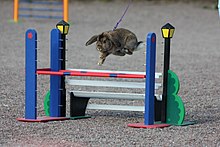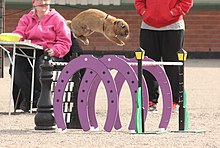Rabbit show jumping
Rabbit show jumping (Swedish: Kaninhoppning[1][2]), also known as rabbit agility[3] or rabbit hopping,[4] is modeled after horse show jumping, on a scale to suit rabbits. Competitions have been held in the United States[4] and several European countries.[3]

History
Rabbit jumping started in Sweden early in the 1970s, when the first rabbit club started to arrange rabbit jumping competitions. At that time, the rules were based on the rules from horse jumping, but were later reformed to be better suited for rabbits.[5] In 1987, the first national championship for "straight course easy level" was held in Stockholm, Sweden. The sport grew throughout Sweden and several rabbit jumping clubs were formed to support the growing interest. In the early 1990s, Norway joined in with rabbit jumping activities, developing new clubs and joining Sweden in rabbit jumping competitions. The Swedish Federation of Rabbit Jumping (SKHRF) was established on September 3, 1994. Rabbit show jumping became popular in all parts of Sweden.
Germany joined the other countries in starting their own rabbit hopping club in 2000. Organizations were established in Norway (2002) and Finland (2004). Training and participation with translations for a new set of rabbit hopping rules came from the judges' committee in Denmark.
2001 brought forth the Rabbit Hopping Organization of America. The rules and guidelines for rabbit hopping were established for all Americans with the help of the judges' committee in Denmark and with personal assistance from hopping judge Aase Bjerner.
The American Hopping Association for Rabbits and Cavies (AHARC) was chartered with the American Rabbit Breeders Association in 2013. The rules and guidelines for this association were molded after RHOA. and Denmark. The AHARC held the very first official national competition in the United States during the 2011 ARBA Convention in Indianapolis, IN. The performance competition for rabbits during 2013 ARBA convention in Harrisburg, Pennsylvania was a Mid Atlantic Rabbit and Cavy event. AHARC will have the first national performance event for cavies during the 2014 ARBA TX convention.
2013 saw the beginnings of The Rabbit Hopping Society Of Australia also with the assistance of Aase and Rasmus Bjerner.
In 2015 Freya Pocock Johansson founded Rabbit Hopping New Zealand.[6]
Record jumps
The world record for the highest rabbit jump is 106 centimetres (42 in), and was achieved in June 2019 by Miss Pinkys Grand Champion Harajuku "Dobby", owned by Julia Samson from Sweden. The same rabbit also holds the world record for longest jump, at 301 centimetres (9.88 ft), achieved in August 2017.[7]
Earlier records
High Jumps:
Snöflingans Majesty of Night (2015) (Sweden) 105 centimetres (41 in)
Snöflingans Majesty of Night (2012) (Sweden) 100 centimetres (39 in)
Tøsen (1997) (Denmark) 99.5 centimetres (39.2 in)
Long Jumps:
Yaboo (1999) (Denmark) 300 centimetres (120 in)
Courses
Official rabbit hopping competitions consist of a straight course, a crooked course, high jump, and long jump.
In a straight course all the obstacles are placed in a straight line and have to be jumped in succession. In a crooked course, the obstacles are placed in an interloping path in which the obstacles must be jumped in the correct order.
Straight and crooked courses are divided into 5 levels.[8]
Mini: Max 26 cm high, 30cm long (6-8 obstacles)
Easy: Max 30 cm high, 45cm long (8 obstacles)
Medium: Max 38 cm high, 65cm long (10 obstacles)
Advanced: Max 45 cm high, 75cm long (10 obstacles)
Elite: Max 50 cm high, 80cm long (12 obstacles)
The mini-course is just an introductory course. In order to progress from easy to medium, etc. a rabbit has to earn promotion points. Rabbits are placed according to the number of faults they have (such as knocking a rail down) time only comes into play if 2 placing rabbits have tied for the same placing.
A rabbit has a set time (usually 2 minutes) to complete the course, if the time runs out before the course is completed, the rabbit is disqualified.
Breeds

All breeds are allowed to compete; however, there may be problems with smaller and larger breeds. (Rabbit size is usually determined by weight: dwarf rabbits are smaller than 2 kilograms (4.4 lb) and giants bigger than 5 kilograms (11 lb).)
The ideal jumping rabbit has long legs and a medium-long back, which will help it correctly judge the height and length of obstacles. In the case of slender bone structures, such as the Belgian Hare, the legs should be strong and muscular so high jumps will not hurt them. In Scandinavia, where rabbit show jumping has a strong base, most are crossbreeds, bred with good jumpers as parents, similar to the method of breeding lurchers, deliberately crossbred racing dogs. It wouldn't be incorrect to say that Scandinavian Jumping Rabbits are their own breed, with well-kept pedigrees.
See also
- Miss Pinkys Grand Champion Harajuku, world record holder in high and long jumping
- Rat agility
- Dog agility
- Cat agility
- Behavioral enrichment
References
- Page 132 in: Williams, Victoria (2015). Weird sports and wacky games around the world: from Buzkashi to Zorbing. Santa Barbara, CA: Greenwood. ISBN 9781610696395. LCCN 2014040274. Retrieved 1 April 2016.
- Ironside, Robyn (3 April 2015). "World's best bunny places: Rabbit-themed attractions around the world". The Daily Telegraph (Australia). Retrieved 1 April 2016.
- "Rabbit Agility". RSPCA - Royal Society for the Prevention of Cruelty to Animals. 2018. Retrieved 26 January 2018.
- "American Hopping Association for Rabbits and Cavies". AHARC.com. Retrieved 26 January 2018.
- http://skhrf.se/english/
- http://rabbithoppingnz.wix.com/rabbithoppingnz
- "http://skhrf.se/rekord/". External link in
|title=(help); Missing or empty|url=(help) - http://skhrf.se/english/
External links
| Wikimedia Commons has media related to Rabbit show jumping. |